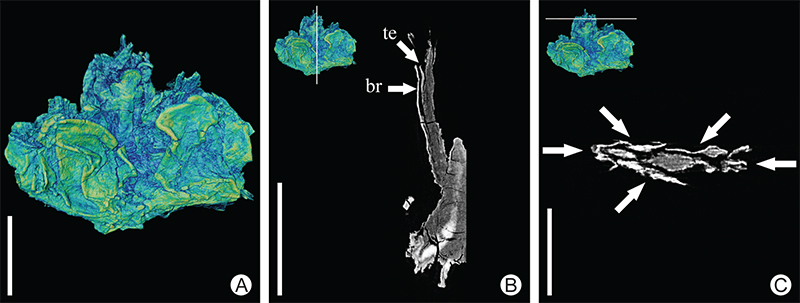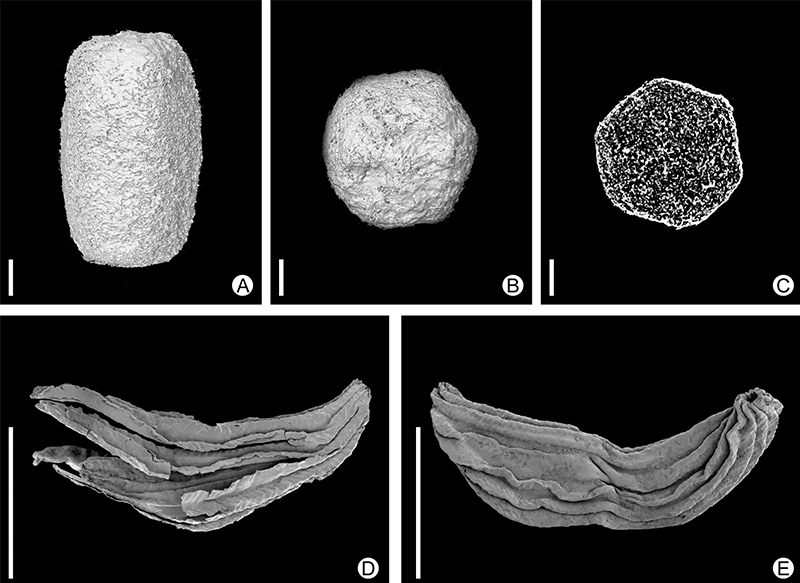FIGURE 1. Geographic and geologic context of the studied mesoflora. A. Extent of Cretaceous outcrops in Central Europe modified after von Gaertner and Walther (1971). Geographic regions in black typeface, mountains in red, waters in blue, geologic units with Cretaceous sediments in green. BCB, Bohemian Cretaceous basin; NSB, North Sudetic Basin; NT, Nysa Trough; OB, Opole Basin. B. Simplified geologic map of the North Sudetic Basin with main towns (black) and the two outcrops with mesoflora (red). Pre-Cretaceous stippled; Cenomanian to lower-middle Coniacian in dark green; upper Coniacian? to Santonian (Czerna Formation) in light green; post-Cretaceous white. C. Palaeogeography of Central Europe in the Late Cretaceous compared to the present geographic setting after Ron Blakey from Csiki-Sava et al. (2015), modified after data in Chatziemmanouil (1982), Surlyk in Voigt et al. (2008) Janetschke and Wilmsen (2014), and Halamski et al. (2016). ESI, East Sudetic Island; RBL, Rhenish-Bohemian Land; WSI, West Sudetic Island.

FIGURE 2. Ricinospora sp. (A) and (C) showing that nearly the whole megaspore is covered with spongiose material, (B) spongiose exinal strengthenings is mainly in the proximal part of spore, a fragment of the trilete laesure is visible. Scale bar for all images 0.1 mm. All specimens from Rakowice Małe locality.

FIGURE 3. Conifers (A) Cunninghamites cf. squamosus terminal fragment of twig, no. K2948, scale bar 1 mm (B) Cunninghamites cf. squamosus isolated leaf with leaf cushion, no. K2956, scale bar 1 mm (C) Cunninghamites cf. squamosus adaxial cuticle showing two bands of stomata, no. K2956, scale bar 100 µm (D) Geinitzia formosa, fragment of twig, no. K2958a scale bar 1 mm (E) Geinitzia formosa, isolated leaf with keel, no. K2958b scale bar 1 mm (F) Geinitzia formosa, detail of abaxial cuticle showing two irregular stomatal bands, no. K2958b scale bar 100 µm (G) Alapaja sp. seed, no. K2962 scale bar 1 mm (H) Seletya sp. seed no. K 3012 scale bar 1 mm (I) Seletya sp. seed no. K 3013, scale bar 1 mm. All specimens from Żeliszów locality.

FIGURE 4. Caryanthus (A) Caryanthus communis broadly elliptical fruit, no. K2899; (B) Caryanthus communis apical part of fruit, no. K2899; (C) Caryanthus communis detail of epidermis, no. K2899 (D) Caryanthus trebecensis ribbed fruit, no. K2900; (E) Caryanthus trebecensis apical part of fruit, no. K2900; (F) Caryanthus trebecensis detail of epidermis, no. K2900; (G) Caryanthus sp. ribbed fruit, no. K2906; (H) Caryanthus sp. apical part of fruit, no. K2906; (I) Caryanthus sp. detail of epidermis, no. K2906; (J) Caryanthus sp. X-ray image, longitudinal/lateral section of fruit, no. K2906; (K) Caryanthus sp. X-ray image, transversal section of fruit, no. K2906; (L) Caryanthus sp. X-ray image longitudinal/adaxial-abaxial section of fruit, no. K2906. Scale bar for all images 0.1 mm. All specimens from Rakowice Małe locality.

FIGURE 5. Caryanthus triasseris (A) ribbed fruit round in outline, no. K2901 (B) apical part of fruit, no. K2901 (C) detail of epidermis, no. K2901 (D) ribbed fruit elliptical in outline, no. K2907 (E) apical part of fruit, no. K2907 (F) detail of epidermis, no. K2907. Scale bar for all images 0.1 mm. All specimens from Rakowice Małe locality.

FIGURE 6. Zlivifructus vachae (A) fruit, round in outline, no. K2903 (B) apical part of fruit, no. K2903 (C) detail of epidermis, no. K2903 (D) fruit, basal pats of stamens arrowed, no. K2905 (E) apical part of fruit, no. K2905 (F) detail of epidermis, no. K2905 (G) X-ray image, longitudinal/adaxial-abaxial section of fruit, no. K2905 (H) X-ray image, longitudinal/lateral section of fruit, no. K2905 (I) X-ray image, transversal section of fruit, no. K2905. Scale bar for all images 0.1 mm. All specimens from Rakowice Małe locality.

FIGURE 7. Fruits of Normapolles (A) Zlivifructus microtriasseris small fruit, basal parts of stamens arrowed, no. K 1290 (B) Zlivifructus microtriasseris apical part of fruit, basal parts of stamens arrowed, no. K 1290 (C) Zlivifructus microtriasseris detail of epidermis, no. K 1290 (D) Normapolles aff., deformed fruit, no. K2904 (E) Normapolles aff., apical part of the fruit, no. K2904 (F) Normapolles aff., apical part of the fruit, basal pats of stamens arrowed (st), basal parts of two very narrow tepals arrowed (te), no. K2904. Scale bar for all images 0.1 mm. All specimens from Rakowice Małe locality.

FIGURE 8. Inflorescence of Normapolles Complex (A) inflorescence formed by three pistillate flowers, no. K2951, scale bar 1 mm (B) inflorescence formed by three staminate flowers, no. K2950, scale bar 1 mm (C) detail showing pollen, no. K2950, scale bar 100 µm; (D) isolated staminate flower showing basal parts of five tepals (terminal part of one tepal removed), no. K2961, scale bar 0.5 mm (E) removed tepal from the specimen figured on image 8D, no. K2961 scale bar 0.5 mm (F) detail of indumentum from the specimen figured on image 8D, no. K2961 scale bar 50 µm. All specimens from Żeliszów locality.

FIGURE 9. Flower of Normapolles affinity; X-ray pictures; specimen no. K2951. (A) inflorescence of three flowers; scale bar 1 mm. (B) Cross section through one flower, showing bract (br) and tepal (te) and documenting the epigynous nature of the flower; scale bar 1 mm. (C) Perianth of each flower consisting of five tepals (arrowed); scale bar 1 mm. Locality Żeliszów.

FIGURE 10. Insect remains (A) insect coprolite no. K2768 (A) coprolithes lateral view, no. K2768, scale bar 0.1 mm, Rakowice Małe locality (B) coprolite apical view, hexagonal in outline, no. K2768, scale bar 0.1 mm, Rakowice Małe locality (C) X-ray image, cross section, no. K2768, scale bar 0.1 mm, Rakowice Małe locality. (D) Costatheca striata no. K3010 scale bar 1 mm, Żeliszów locality (E) Costatheca striata showing “operculum” no. K3011 scale bar 1 mm. Żeliszów locality.


